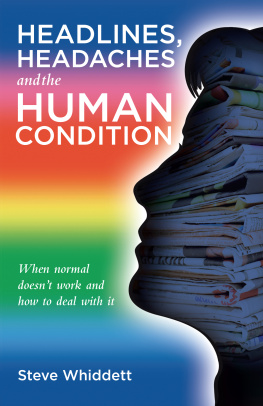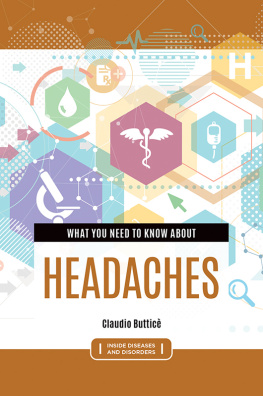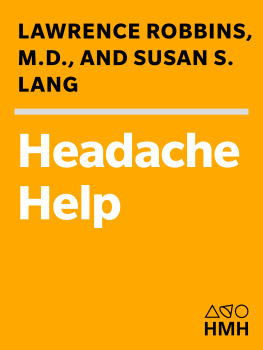
Foreword by Dr. Seymour Diamond, National Headache Foundation
Gary Ruoff, MD

Copyright 2013 Gary Ruoff
All rights reserved under International and Pan American Copyright Conventions.
No part of this book may be reproduced or transmitted in any form or by any means electronic or mechanical including photocopying and recording, or by any information storage and retrieval system, without permission in writing from the publisher.
Spry Publishing LLC
2500 South State Street
Ann Arbor, MI 48104 USA
www.sprypub.com
10 9 8 7 6 5 4 3 2 1
Library of Congress Cataloging-in-Publication Data on file.
ISBN: 978-1-938170-08-9 (e-Book)
Disclaimer: Spry Publishing LLC does not assume responsibility for the contents or opinions expressed herein. Although every precaution is taken to ensure that information is accurate as of the date of publication, differences of opinion do exist. The opinions expressed herein are those of the author and do not necessarily reflect the views of the publisher. Spry Publishing LLC does not recommend or endorse any specific tests, physicians, products, procedures, opinions, or other information that may be contained in this publication. The information contained in this book is not intended to replace the professional advisement of a patients doctor regarding medical information, diagnosis, or treatment.
Dedication
I dedicate this to my loving wife Cynthia and
children Gary Stephen and Laura Anne
who supported me in my career in medicine.
I also wish to dedicate this book to the many wonderful
patients and headache sufferers throughout the nation.
Lastly, Id like to acknowledge Robin Porter for her
editorial contributions to the book.
Foreword
It is indeed an honor to write this foreword at the invitation of my friend and colleague Gary Ruoff, MD. I have known Dr. Ruoff for many years, even before he began treating headaches, and have watched his evolution into one of the most proficient and compassionate physicians specializing in headache medicine. His knowledge has been fortified by his years of clinical research.
This book will not only be of great value to headache patients but will also serve as a resource to their families, friends, colleagues, and employers or teachers. This concise, well-researched, and knowledgeable book should be in the library of every headache patient.
Over the years, neurologists have come to dominate headache medicine. This was not always the case as internists, general practitioners, and other medical specialties were involved in the management of headacheand remain so. There is something special about this book. It is not only easily readable, but it is highly organized and an excellent source of information. It provides the patient with tools to successfully manage their problem. Above all, a book directed to headache patients should be written by an understanding and experienced primary care physician such as Dr. Ruoff.
I was asked to critique the manuscript and offer suggestions for improvement. While reading, I found little to add or detract. The explanations are simple yet thorough. The charts are easy to read and concise. Dr. Ruoff recognizes the value of a complete headache history and identifies the most valuable question in the patient interviewHow many types of headache do you experience?
In 1973, Dr. Donald Dalessio and I published a book directed to all physicians who managed headache patientsThe Practicing Physicians Approach to the Difficult Headache Patient. Our goal, throughout the first five editions of this textbook, was to produce simple and practical solutions to headache management for physicians of all specialties. In his book, Dr. Ruoff has successfully provided the headache patient with simple and practical information so that they can be advocates for their own care. He recognizes the role of the patient in dealing with the illness and how they can serve as a partner in headache management. This book is a welcome addition to the inventory of headache books.
Seymour Diamond, MD
Executive Chairman and Founder
National Headache Foundation
Chicago, Illinois
Table of Contents
So you have headaches. Perhaps youve suffered from headaches for a number of years. When they first started, they may have only been a nuisance, easily controlled with over-the-counter (OTC) medications, or by simply gutting it out until the pain passed. Now, however, your headaches are occurring more often and are becoming more severe. Worse, the medications you relied on in the past are less effective or have become completely ineffective. Headaches may be interfering with your daily lifecausing you to be less efficient at work, pass up social engagements, or miss out on family activities. Your headaches might be accompanied by sensitivity to light, sound, or even certain smells. Sometimes you may feel disoriented or light-headed. Your neck and shoulders may begin to tighten. What begins as a dull ache in your head intensifies as the hours pass, eventually developing into a sick headache, which could include nausea and vomiting. Even the slightest motion of your head or body seems to make the headache more intense. At this point, all you want to do is find a dark room, crawl into bed, and stay there until the pain is gone.
If this sounds familiar, then youve picked up the right book. As a family physician for over 40 years, Ive treated patients with a wide range of health issues. Over time, I developed a special interest in pain management, particularly for people suffering from chronic headaches. Eventually I became certified in headache treatment, but I never lost sight of what I found most gratifying as a family physicianthe treatment of the whole patient. I dont treat just headaches; I treat people who suffer from headaches. When I first see a patient, I expect to spend an hour or more gathering information. I want to know everything, from family medical history and possible underlying health problems, to past success (or lack of success) with medications, as well as the patients current stress level. I believe it takes time and a great deal of listening to make an accurate diagnosis and develop a successful treatment plan for any patient, especially those who have become frustrated or disheartened by a chronic condition, such as headaches.
Just as it is important for a physician to get to know the patient, I believe an informed patient is a good patient, and can be treated with more success. Thats really what prompted me to write this book. The first step in treating any medical condition is to know what youre dealing with. Today, more than ever, information is readily available at a click of a button. However, medical data can often be confusing, contradictory, or even misleading. In addition, the sheer amount of information online can be overwhelming. It is my sincere hope that this book will help you make sense of this information, and arm you with the knowledge you need to control your headaches. It is not meant as a replacement for professional medical advice, but rather as a starting point for creating a dialogue with your doctor, as well as a resource for managing your headaches.
While Ive helped patients with a myriad of health issues, including many life-threatening conditions, it is, most often, the headache sufferer who comes back to thank me for giving me my life back. Why are headache patients so grateful? Because many of them have reached a point of surrender. They feel they have tried everything, exhausted all their resources, and still found no relief. Some of them have even been told that its all in their heads (quite literally), and have sadly resigned themselves to living with chronic headaches. Perhaps you have also reached that point. If so, I urge you not to give up.
Next page









